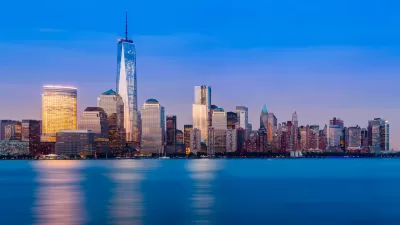New York Times Architecture Critic Michael Kimmelman unequivocally pans the newly opened 1 World Trade Center as a cautionary tale: "The point is that something better was possible in Lower Manhattan."
The paper of record has released its architectural review of one of the most eagerly anticipated buildings in American history. To put it mildly, Michael Kimmelman is not a fan of the tallest building in North America. A sampling of his critiques:
- "Like the corporate campus and plaza it shares, 1 World Trade speaks volumes about political opportunism, outmoded thinking and upside-down urban priorities. It’s what happens when a commercial developer is pretty much handed the keys to the castle. Tourists will soon flock to the top of the building, and tenants will fill it up. But a skyscraper doesn’t just occupy its own plot of land. Even a tower with an outsize claim on the civic soul needs to be more than tall and shiny."
- "Replacing the twin towers with another giant office building was somehow supposed to show New York’s indomitable spirit: the defiant city transfigured from the ashes. To the contrary, 1 World Trade implies (wrongly) a metropolis bereft of fresh ideas. It looks as if it could be anywhere, which New York isn’t."
- "Stripped of prospective cultural institutions, as well as of street life and housing, the plan soon turned into something akin to an old-school office park, destined to die at night — the last thing a young generation of New Yorkers wanted."
Chicago Tribune Architecture Critic Blair Kamin produced a less-than-stellar review of 1 World Trade Center back in October.
FULL STORY: A Soaring Emblem of New York, and Its Upside-Down Priorities

Trump Administration Could Effectively End Housing Voucher Program
Federal officials are eyeing major cuts to the Section 8 program that helps millions of low-income households pay rent.

Planetizen Federal Action Tracker
A weekly monitor of how Trump’s orders and actions are impacting planners and planning in America.

Ken Jennings Launches Transit Web Series
The Jeopardy champ wants you to ride public transit.

New Mexico Aging Department Commits to Helping Seniors Age ‘In Place’ and ‘Autonomously’ in New Draft Plan
As New Mexico’s population of seniors continues to grow, the state’s aging department is proposing expanded initiatives to help seniors maintain their autonomy while also supporting family caregivers.

USDOT Waters Down Self-Driving Car Regulations
The agency is reducing reporting requirements for autonomous vehicles and cars with self-driving features, prompting concern among safety advocates who say transparency is essential to the safe deployment of AV technology.

‘Minnesota Nice’ Isn’t so Nice When You Can’t Find a Place to Live
The Economic Development and Housing Challenge Program can help address the scourge of homelessness among Indigenous people.
Urban Design for Planners 1: Software Tools
This six-course series explores essential urban design concepts using open source software and equips planners with the tools they need to participate fully in the urban design process.
Planning for Universal Design
Learn the tools for implementing Universal Design in planning regulations.
Heyer Gruel & Associates PA
Ada County Highway District
Institute for Housing and Urban Development Studies (IHS)
City of Grandview
Harvard GSD Executive Education
Toledo-Lucas County Plan Commissions
Salt Lake City
NYU Wagner Graduate School of Public Service



























